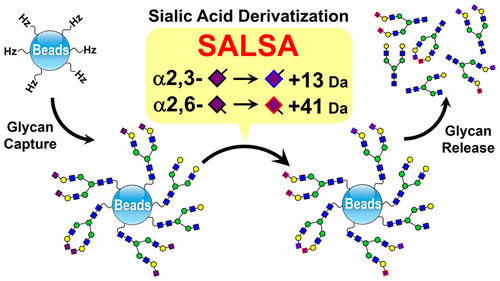当前位置:
X-MOL 学术
›
Anal. Chem.
›
论文详情
Our official English website, www.x-mol.net, welcomes your
feedback! (Note: you will need to create a separate account there.)
Differentiation of Sialyl Linkage Isomers by One-Pot Sialic Acid Derivatization for Mass Spectrometry-Based Glycan Profiling
Analytical Chemistry ( IF 6.7 ) Pub Date : 2017-02-08 00:00:00 , DOI: 10.1021/acs.analchem.6b04150 Takashi Nishikaze 1 , Hiroki Tsumoto 2 , Sadanori Sekiya 1 , Shinichi Iwamoto 1 , Yuri Miura 2 , Koichi Tanaka 1
Analytical Chemistry ( IF 6.7 ) Pub Date : 2017-02-08 00:00:00 , DOI: 10.1021/acs.analchem.6b04150 Takashi Nishikaze 1 , Hiroki Tsumoto 2 , Sadanori Sekiya 1 , Shinichi Iwamoto 1 , Yuri Miura 2 , Koichi Tanaka 1
Affiliation

|
Matrix-assisted laser desorption/ionization mass spectrometry (MALDI-MS) has been used for high-throughput glycan profiling analysis. In spite of the biological importance of sialic acids on nonreducing ends of glycans, it is still difficult to analyze glycans containing sialic acid residues due to their instability and the presence of linkage isomers. In this Article, we describe a one-pot glycan purification/derivatization method employing a newly developed linkage-specific sialic acid derivatization for MS-based glycan profiling with differentiation of sialyl linkage isomer. The derivatization, termed sialic acid linkage specific alkylamidation (SALSA), consists of sequential two-step alkylamidations. As a result of the reactions, α2,6- and α2,3-linked sialic acids are selectively amidated with different length of alkyl chains, allowing distinction of α2,3-/α2,6-linkage isomers from given mass spectra. Our studies using N-glycan standards with known sialyl linkages proved high suitability of SALSA for reliable relative quantification of α2,3-/α2,6-linked sialic acids compared with existing sialic acid derivatization approaches. SALSA fully stabilizes both α2,3- and α2,6-linked sialic acids by alkylamidation; thereby, it became possible to combine SALSA with existing glycan analysis/preparation methods as follows. The combination of SALSA and chemoselective glycan purification using hydrazide beads allows easy one-pot purification of glycans from complex biological samples, together with linkage-specific sialic acid stabilization. Moreover, SALSA-derivatized glycans can be labeled via reductive amination without causing byproducts such as amide decomposition. This solid-phase SALSA followed by glycan labeling has been successfully applied to human plasma N-glycome profiling.
中文翻译:

一锅唾液酸衍生化用于基于质谱的聚糖分析的唾液酸键联异构体的区分
基质辅助激光解吸/电离质谱(MALDI-MS)已用于高通量聚糖谱分析。尽管唾液酸在聚糖的非还原端上具有生物学重要性,但由于其不稳定性和存在连接异构体,仍然难以分析含有唾液酸残基的聚糖。在本文中,我们描述了一种单锅聚糖纯化/衍生化方法,该方法采用了新开发的基于键的唾液酸衍生化方法,用于基于MS的聚糖谱分析,并具有唾液酸键异构体的区分。衍生化,称为唾液酸键特异性烷基酰胺化(SALSA),由连续的两步烷基酰胺化组成。反应的结果是,α2,6-和α2,3-连接的唾液酸被不同长度的烷基链选择性酰胺化,可以从给定的质谱中区分出α2,3-/α2,6-键的异构体。我们的研究使用ñ与现有的唾液酸衍生化方法相比,具有已知唾液酸键的β-聚糖标准品证明SALSA非常适合对α2,3-/α2,6-连接的唾液酸进行可靠的相对定量。SALSA通过烷基酰胺化作用可完全稳定α2,3-和α2,6-连接的唾液酸。因此,可以将SALSA与以下现有的聚糖分析/制备方法结合使用。SALSA和使用酰肼珠的化学选择性聚糖纯化相结合,可轻松从复杂的生物样品中一锅法纯化聚糖,并具有连接特异性唾液酸稳定作用。此外,可以通过还原胺化标记SALSA衍生的聚糖,而不会引起副产物(如酰胺分解)。此固相SALSA及其后的聚糖标记已成功应用于人体血浆N糖基分析。
更新日期:2017-02-08
中文翻译:

一锅唾液酸衍生化用于基于质谱的聚糖分析的唾液酸键联异构体的区分
基质辅助激光解吸/电离质谱(MALDI-MS)已用于高通量聚糖谱分析。尽管唾液酸在聚糖的非还原端上具有生物学重要性,但由于其不稳定性和存在连接异构体,仍然难以分析含有唾液酸残基的聚糖。在本文中,我们描述了一种单锅聚糖纯化/衍生化方法,该方法采用了新开发的基于键的唾液酸衍生化方法,用于基于MS的聚糖谱分析,并具有唾液酸键异构体的区分。衍生化,称为唾液酸键特异性烷基酰胺化(SALSA),由连续的两步烷基酰胺化组成。反应的结果是,α2,6-和α2,3-连接的唾液酸被不同长度的烷基链选择性酰胺化,可以从给定的质谱中区分出α2,3-/α2,6-键的异构体。我们的研究使用ñ与现有的唾液酸衍生化方法相比,具有已知唾液酸键的β-聚糖标准品证明SALSA非常适合对α2,3-/α2,6-连接的唾液酸进行可靠的相对定量。SALSA通过烷基酰胺化作用可完全稳定α2,3-和α2,6-连接的唾液酸。因此,可以将SALSA与以下现有的聚糖分析/制备方法结合使用。SALSA和使用酰肼珠的化学选择性聚糖纯化相结合,可轻松从复杂的生物样品中一锅法纯化聚糖,并具有连接特异性唾液酸稳定作用。此外,可以通过还原胺化标记SALSA衍生的聚糖,而不会引起副产物(如酰胺分解)。此固相SALSA及其后的聚糖标记已成功应用于人体血浆N糖基分析。





















































 京公网安备 11010802027423号
京公网安备 11010802027423号